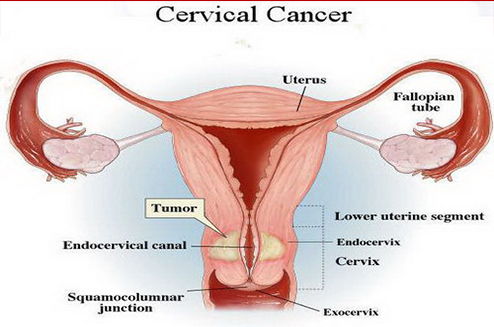
Cervical cancer is a cancer that begins in the cervix, the part of the uterus or womb that opens into the vagina
It is the part of the uterus that dilates and opens fully to allow a baby to pass into the birth canal.
The normal cervix has two main types of cells: Squamous or flat cells, that protect the outside of the cervix and Glandular cells, that are mostly inside the cervix, that make the fluid and mucus commonly seen during ovulation.
It is caused by abnormal changes in either of these cell types in the cervix, and is the only gynecologic cancer that can be prevented by regular screening and preventive vaccination. Cervical cancer usually affects women between the ages of 30 and 55.
Cervical cancer and cervical pre-cancers usually have no symptoms. That is why it is important to have a Pap test. A woman usually does not have any symptoms until the cells turn into cancer and invade the deepest parts of the cervix or other pelvic organs.
These are common symptoms in women who have developed cervical cancer.
These symptoms may be caused by cancer or by other health problems. It is important for a woman to see her doctor if she is having any of these symptoms.
When a woman experiences concerning symptoms, a pelvic exam, including a rectovaginal exam, and a general physical should be performed. If the exam is abnormal, the woman might be recommended to undergo an HPV test or a colposcopy (observing the cervix through a magnifying scope) and a biopsy, depending upon the results of the colposcopy. If there is a frank growth/lesion, a biopsy maybe performed directly. Additional Investigations like CTscan/ MRI of the abdomen or pelvis may be performed if indicated. If cervical cancer is suspected or diagnosed, it is important to seek care first from a surgical oncologist.
Treatment usually depends on the clinical/radiological stage of the tumor. Surgery is the most common treatment for early cervical cancer, although radiation can also be used. The final choice for you will depend on several factors ,especially the stage and size of your cancer as well as your general health.
Radical Abdominal Hysterectomy may be performed through an abdominal incision or laparoscopically. The word 'Radical' means that the uterus and the tissue between the uterus and pelvic wall, as well as part of the upper vagina, are removed. Lymph nodes in the pelvis are also removed and examined to determine if the cancer has spread (radical pelvic lymphadenectomy). In some cases, both ovaries and both fallopian tubes may be removed. Surgery can be done laparoscopically or robotically in selected cases.
Radiation therapy (also called radiotherapy) uses high-energy radiation to kill cancer cells or stop them from growing. Radiation therapy can be an effective treatment for early stage cervical cancers. However, in early cervical cancer, it is more commonly used as extra treatment after surgery for patients at highest risk for recurrence of their cancer (such as when the tumor might have spread beyond the cervix). Radiation is also used to treat larger or higher stage cancers where it is actually works better than surgery. Your individual need for radiation therapy will be determined using information from your staging tests, examinations, and surgery, if an operation was performed from findings at the time of your evaluation.Radiation therapy for cervix cancer is most often given in combination with chemotherapy.
Two types of radiation therapy are used to treat cervical cancer.
External Radiation Therapy uses a machine that directs the radiation toward a precise region of the body. The therapy is usually given daily, Monday through Friday, for about six weeks. Radiation does not hurt during the treatment and only takes a few minutes each day. You can be treated at a clinic, hospital, or radiation oncology office, and typically you return home each day after treatment.
Internal Radiation Therapy (also called brachytherapy) involves placing a small capsule of radioactive material inside the vagina or near the cervix. This procedure can sometimes be performed on an outpatient basis, and other times it requires hospitalization for a night or two.
The side effects of radiation therapy depend on the dose used and the part of the body that is being treated. Common side effects for cervix cancer patients are listed below.
Early side effects (occur during treatment):
Most of these side effects are temporary. Not everybody experiences all of these side effects. Be sure to talk with your treatment team members about any side effects you experience. They can help you find ways to manage them.
Long time side effects from radiation therapy include:
